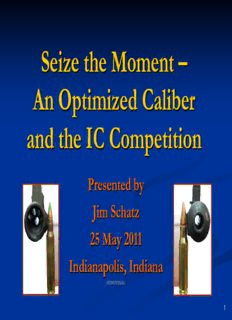
Caseless Small Arms Ammunition The Good, The Bad, The Ugly PDF
Preview Caseless Small Arms Ammunition The Good, The Bad, The Ugly
Seize the Moment – An Optimized Caliber and the IC Competition Presented by Jim Schatz 25 May 2011 Indianapolis, Indiana 052411FINAL 1 John Hall: A Greater Degree of Perfection 21 May 2011 – 200th Year Anniversary of the Hall Breech-loading Rifle. Hall’s “Straight-cutting Machine” (Milling Machine forerunner) and “Uniformity Principle” for fully interchangeable parts. 2 Purpose ◘ Propose a alternate approach to guarantee a “substantial and significant improvement” in carbine, rifle, and LMG performance within the current US Army Near – Long Term planning using existing funds. ◘ Avoid an Individual Carbine competition “fielding failure”. Candidates in other than 5.56mm?? ◘ Double the Maximum Effective Range (MER) and substantially increase the Terminal Effectiveness of US small arms for the joint US/NATO/OGA war fighters for year 2012 and beyond. 3 Caveats ◘ The author is a proponent not of any particular caliber/cartridge but of an objective Analysis of Alternatives to 5.56mm NATO BEFORE we test, select and field the next generation of weapons. 2008 IC ID 2009 NDIA & 2008 NDIA 2010 NDIA & ESACS JAT DST ◘ The briefing contents are the educated opinions of the author compiled from public domain information. ◘ The author is an independent and has no stake in the IC competition, financial or otherwise. 4 The Path Forward ◘ Near Term (2011-2013) GOOD IDEA Field Additional M4/M4A1 Carbines ◘ Short Term (2011-2016) “Dual Path” GREAT! -Enhance the Current Carbine (PIP’s) DO IT! ANOTHER 5.56? -Conduct the IC Competition Why? ◘ Long Term (2016-2020+) MORE 5.56? Light Weight Ammunition Why? & Small Arms (LSAT?) - or not? Why Not an OC? 5 Paradigm Shifting Data - A Game Changer? ◘ Past and recent “Caliber Studies”, such as the Joint Services Wound Ballistics IPT Engineering Study ES-1A-9001 Public Release report dated July 31, 2006 determined that from an overall performance standpoint that the caliber .224”(aka “5.56 mm NATO”) IS NOT the best caliber choice for optimum assault rifle/LMG target effects. ◘ That a caliber between .257” (6.5 mm) and .277” (7.0 mm) is in fact optimum in regards to muzzle and impact energy, recoil impulse vs. system weight, barrier and post-barrier penetration, terminal effectiveness, P(I), P(H) etc. when compared to 5.56mm NATO and 7.62mm NATO. So why ask for a new Individual Carbine in 5.56mm? 6 General Caliber Conclusions ◘ Larger caliber bullets inflict more damage on target. ◘ Larger calibers provide superior target effects after barrier penetration. ◘ 6.5mm-7mm target damage is greater than the increase in system weight from 5.56mm to 6.5-7mm ◘ 7mm equals 7.62mm (by weight) against barriers. ◘ 6.5mm-7mm (by weight, recoil impulse, combat load) offers the greatest terminal effects compared to 5.56mm and 7.62mm. We should conduct “Optimized Caliber” (OC) Testing and Selection BEFORE IC release! 7 We’ve Been Here Before! Assault Rifle/LMG Caliber “Sweet Spot” = .257 (6.5mm) - .277 (7mm) .276 Pederson (.284/7.2mm) – US 1932 M1 Garand Adoption .280 British (7mm) – UK 1950 EM-2 NATO Contender .258 Win. (6.6mm) – US 1959 AR-15 .277 (6.8x43mm SPC) – US 2000’s .257 (6.5mm Grendel) US 2002 A partial list 2011/12 – IC? only! 2016/20 – LSAT? 8 Photo credit: Anthony Williams The Problem Evidence of the need for something more effective than 5.56mm M855/SS109. ◘ All current US Army 2002 – USASFC/5th SFG(A) – Enhanced Rifle Cartridge efforts (M4 PIP, IC, 2006 – Soldier Perspectives on Small Arms in Combat 2006 – JSWB-IPT LSAT) do not 2006 – USMC Alternate Ammo Study Phase 1 substantially increase 2007 – TSWG MURG Test Report 2009 – Canadian Forces Wound Ballistics Review the MER or terminal 2009 – Taking back the Infantry Half-Kilometer effectiveness of the 2009 – NSWC Comparison of Terminal Ballistic Performance (5.56, 6.8, 7.62) weapons because they 2010 – USMC GEN Mattis “Interest in shifting to a are oriented to caliber higher caliber assault rifle” Since 1996 – Development/fielding of M855 .224 and the limitations LFS/A1/EPR, MK318 SOST, 6.8x43mm, of the current 5.56mm 6.5G, Barnes Brown Tip, UK HP 5.56, etc. Since 2001 – Fielding of many more 7.62x51mm AR’s, NATO cartridge and LMG’s, SDMR’s throughout US and NATO 2011 – IC Competition “Non-caliber Specific” projectile envelopes. A partial list above. More at the link provided below. http://www.hkpro.com/forum/showthread.php?t=138175&p=1020038&highlight=#post1020038 9 The Proof ◘ NLT 40 important programmatic examples since 2001 of US and NATO efforts to enhance the MER and terminal effects of 5.56mm small arms or replace 5.56mm weapons with 7.62x51mm rifles and LMG’s (M14 SDMR, MK17, UK L129A1, HK417, Larue OBR’s, SR25 EMC’s, MK48’s, etc.): -Canada, France, Germany, Norway, UK, US, SOCOM, etc. -Most recently AUS and NZ as standard issue. ◘ Threat tactics, efforts - 7.62x54R “Stand-off Shooters” in AFG and PRC 5.8x42mm Improvements, to name just a few. ◘ “Intermediate” Caliber successes abound - .40 S&W in US SOF & USCG, PIP’d .300 WM/.338 for PSR, 25mm vs. 40mm, 6.8mm & .300 Blackout, 4.6mm and .45 ACP CAP vs. 9mm. ◘ 5.56mm NATO SS109 “abandonment” in USSOCOM & USMC (SOST), US Army (M855A1), UK/BAE HP 5.56 10
Description: